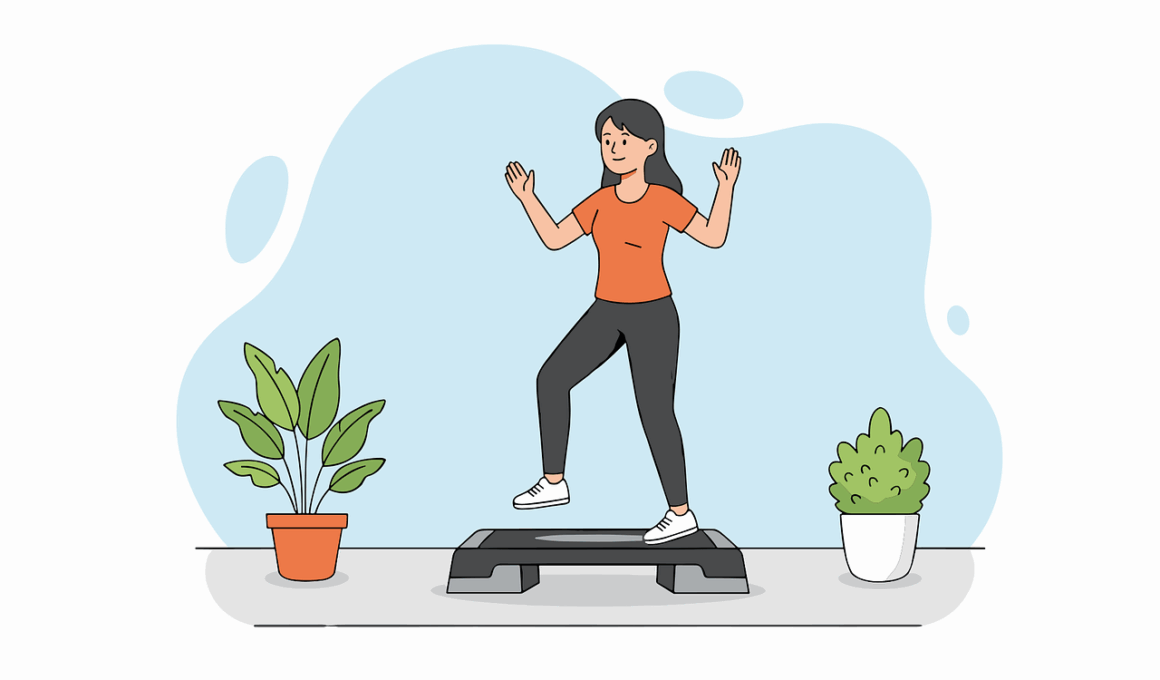Incorporating Plyometrics into Home Endurance Training
Plyometric training is an excellent way to boost endurance while enhancing strength. This form of exercise relies on explosive movements that engage both fast-twitch and slow-twitch muscle fibers. The primary aim is to increase your power and speed, which are crucial for endurance sports. Home workouts often limit equipment, but plyometrics can be performed effectively using body weight alone. Exercises like jump squats, box jumps, and lateral hops can easily be incorporated into your regular routine. Mixing these exercises into your endurance training can lead to significant improvements in athletic performance. Furthermore, plyometrics help improve coordination and balance, which are critical for activities such as running or cycling. It’s important to approach these exercises gradually, focusing on technique before increasing intensity. This ensures safety and reduces the potential for injury while maximizing the benefits. Additionally, plyometrics can elevate your heart rate, burning more calories while enhancing muscular endurance. As with any training regimen, be sure to include a proper warm-up and cooldown to prevent muscle strain and maintain flexibility. With consistent practice, plyometric exercises can bring about transformative changes to your endurance capabilities.
Integrating plyometric training into your existing endurance routine should be done with a strategic approach. Start by scheduling specific days each week where you can focus on these explosive movements. This will ensure adequate recovery time in between sessions. For beginners, it’s advisable to limit the number of jumps or explosive efforts performed in a week. Higher repetitions can lead to faster fatigue levels, which might hinder endurance performance. You should also pair plyometric exercises with traditional endurance workouts, such as running or cycling, to complement the gains you’re making. Implementing a circuit-style workout can be particularly effective. For instance, you might alternate between jumping exercises and aerobic activities like jogging or brisk walking. Additionally, using intervals can boost your training effectiveness, improving both cardiovascular and muscular endurance over time. As you progress, increase the difficulty by adding more jumps or decreasing rest periods. Pay attention to your body’s feedback; any persistent soreness or pain indicates a need to modify your workouts. This strategic incorporation will help create a well-rounded fitness program, benefiting your overall performance, and enhancing your responsiveness during endurance activities.
Plyometric Exercise Variations
When it comes to plyometrics, there are countless variations to keep you engaged in your training. Incorporate exercises such as tuck jumps, where you jump upward and bring your knees to your chest, or broad jumps to increase lateral movement power. Box jumps are another fantastic option, allowing you to develop explosive leg strength while enhancing your cardiovascular health. Skater jumps, which also focus on lateral movement, will give you the endurance and agility essential for team sports. Moreover, burpees serve as a great full-body workout that combines plyometric training with strength elements. These exercises can be done with minimal or no equipment, making them suitable for home workouts. To maintain variation, try performing different exercises each session or alternating between low-impact and high-impact movements. You can also increase or decrease the speed at which you perform exercises to add a further challenge. When exploring these variations, focus on form to ensure maximum effectiveness and prevent injuries. Engaging in plyometric training at home can provide a structured workout that emphasizes coordination while boosting your endurance levels effectively.
One major benefit of plyometric exercises is their ability to improve your overall athleticism. By incorporating these dynamic movements into your endurance training, you aid muscle recruitment and improve force production in your legs. This results in more efficient running, cycling, or swimming. Furthermore, strong muscles are less prone to injuries, especially tendons and ligaments. Particularly, the explosive nature of plyometrics increases power output, allowing you to sustain efforts longer and faster, which is beneficial during races or intense training sessions. Another advantage of plyometric exercises includes their versatility. They require minimal space and no specialized equipment, making them perfect for home workouts. This accessibility encourages consistency since you can complete workouts on your own schedule. Remember to maintain a focused mindset during training sessions, as mental engagement enhances performance outcomes. Visualize your goals and commit fully to the prescribed exercises. This dedicated approach will positively influence your physical gains. As you conquer each set or circuit, you should notice improvements in your recovery time and overall stamina during endurance activities.
Safety and Recovery Tips
When engaging in plyometrics, safety is paramount. Begin with a thorough warm-up that incorporates dynamic stretches to prepare your muscles for explosive movements. Pay special attention to your landing mechanics; landing softly with bent knees can help absorb impact and prevent injury. Always focus on quality over quantity by prioritizing proper form over the number of repetitions. This is particularly important for newcomers to plyometric training. Additionally, consider including lower-impact alternatives if you have existing joint issues or concerns, gradually increasing the intensity as you feel more comfortable. Recovery is just as important as the workout itself; ample rest days are essential for muscle repair and growth. Proper hydration and nutrition will also support your training efforts effectively. Incorporate foam rolling and stretching to enhance flexibility and alleviate soreness post-workout. Skipping adequate recovery or ignoring discomfort can lead to long-term setbacks. If you begin to feel fatigued or notice a decline in performance, consider scaling back on plyometric exercises. Integrating a healthy mix of plyometric workouts alongside endurance training can yield impressive fitness outcomes while keeping you safe along the way.
Establishing a balanced home workout routine that includes plyometrics can lead to significant fitness advancements. Incorporating various workouts not only helps prevent boredom but also ensures you engage different muscle groups effectively. You may alternate between traditional endurance workouts like running or cycling and plyometric exercises, allowing you to focus on both cardiovascular fitness and explosive strength. Tracking your progress will yield motivational boosts, so consider noting your achievements in a workout journal or app. This method keeps you accountable and offers insights into your improvement over time. Try different formats such as circuit training or pyramid workouts to maximize your effectiveness. Plyometric sessions can be brief but effective; five to 10 minutes can yield desirable results without causing excessive fatigue. Listen to your body and adjust your sessions as needed. Keep in mind, consistency is key for achieving results. Building muscular endurance through plyometrics will not only enhance your performance in other sports but will also boost your confidence in your abilities. Celebrate your small victories, and you will find greater motivation to continue your journey toward fitness through home workouts.
Final Thoughts
Home workouts can be incredibly effective in improving your endurance when you strategically incorporate plyometric exercises. These explosive movements enhance overall strength while developing muscular endurance required for various sports and activities. With minimal equipment needed, it’s an accessible way to increase your fitness levels effectively. As you continue on your fitness journey, remember that each session contributes to your overall goals, whether it’s for a competition or personal achievement. Staying mindful of your body and honing your techniques will pave the way for steady progress while minimizing the risk of injury. Reflecting on your workouts and making small adjustments will boost your performance significantly. Consistency, safety, and dedication to your routines will yield positive changes and improvements. Ultimately, integrating plyometric training into your routine will help you become a well-rounded athlete. As you explore the various exercises, stay patient and give your body the time it needs to adapt and strengthen. Embrace the challenge, celebrating milestones along the way, and you will discover how rewarding home workouts can truly be for developing endurance and overall fitness.


